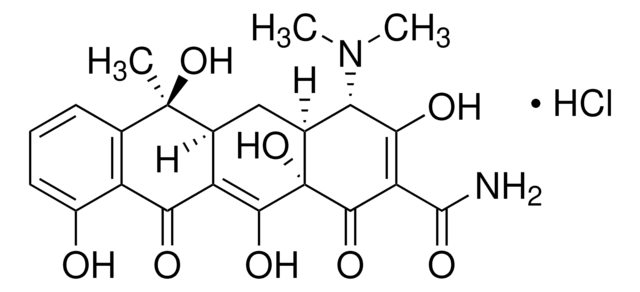E5389
Erythromycin
powder, suitable for cell culture, BioReagent
Sinônimo(s):
E-Mycin, Erythrocin
About This Item
Produtos recomendados
Nome do produto
Erythromycin, BioReagent, suitable for cell culture
linha de produto
BioReagent
Formulário
powder
potência
≥850 μg per mg
técnica(s)
cell culture | mammalian: suitable
Impurezas
≤0.1 EU/mg endotoxin
cor
white
pf
133 °C
solubilidade
2 M HCl: 50 mg/mL (Stock solutions should be stored at 2-8 °C. Stable at 37 °C for 3 days.)
ethanol: soluble (Stock solutions should be stored at 2-8 °C. Stable at 37 °C for 3 days.)
espectro de atividade do antibiótico
Gram-negative bacteria
Gram-positive bacteria
Modo de ação
protein synthesis | interferes
cadeia de caracteres SMILES
CC[C@H]1OC(=O)[C@H](C)[C@@H](O[C@H]2C[C@@](C)(OC)[C@@H](O)[C@H](C)O2)[C@H](C)[C@@H](O[C@@H]3O[C@H](C)C[C@@H]([C@H]3O)N(C)C)[C@](C)(O)C[C@@H](C)C(=O)[C@H](C)[C@@H](O)[C@]1(C)O
InChI
1S/C37H67NO13/c1-14-25-37(10,45)30(41)20(4)27(39)18(2)16-35(8,44)32(51-34-28(40)24(38(11)12)15-19(3)47-34)21(5)29(22(6)33(43)49-25)50-26-17-36(9,46-13)31(42)23(7)48-26/h18-26,28-32,34,40-42,44-45H,14-17H2,1-13H3/t18-,19-,20+,21+,22-,23+,24+,25-,26+,28-,29+,30-,31+,32-,34+,35-,36-,37-/m1/s1
chave InChI
ULGZDMOVFRHVEP-RWJQBGPGSA-N
Informações sobre genes
human ... ABCB1(5243) , CYP3A4(1576) , MLNR(2862)
mouse ... Abcb1a(18671) , Abcb1b(18669)
Procurando produtos similares? Visita Guia de comparação de produtos
Descrição geral
Aplicação
- as a supplement for nutrient broth medium for culturing green fluorescent protein (GFP)- expressing E. coli
- as a model drug to determine small intestinal (SMI) microtissue viability using the MTT assay{254
- as an antibiotic to study the treatment strategies of chronic infections
Ações bioquímicas/fisiológicas
Antimicrobial Spectrum: This product acts against both gram-negative and gram-positive bacteria.
Atenção
Nota de preparo
Código de classe de armazenamento
11 - Combustible Solids
Classe de risco de água (WGK)
WGK 3
Ponto de fulgor (°F)
Not applicable
Ponto de fulgor (°C)
Not applicable
Equipamento de proteção individual
Eyeshields, Gloves, type N95 (US)
Escolha uma das versões mais recentes:
Já possui este produto?
Encontre a documentação dos produtos que você adquiriu recentemente na biblioteca de documentos.
Os clientes também visualizaram
Nossa equipe de cientistas tem experiência em todas as áreas de pesquisa, incluindo Life Sciences, ciência de materiais, síntese química, cromatografia, química analítica e muitas outras.
Entre em contato com a assistência técnica







